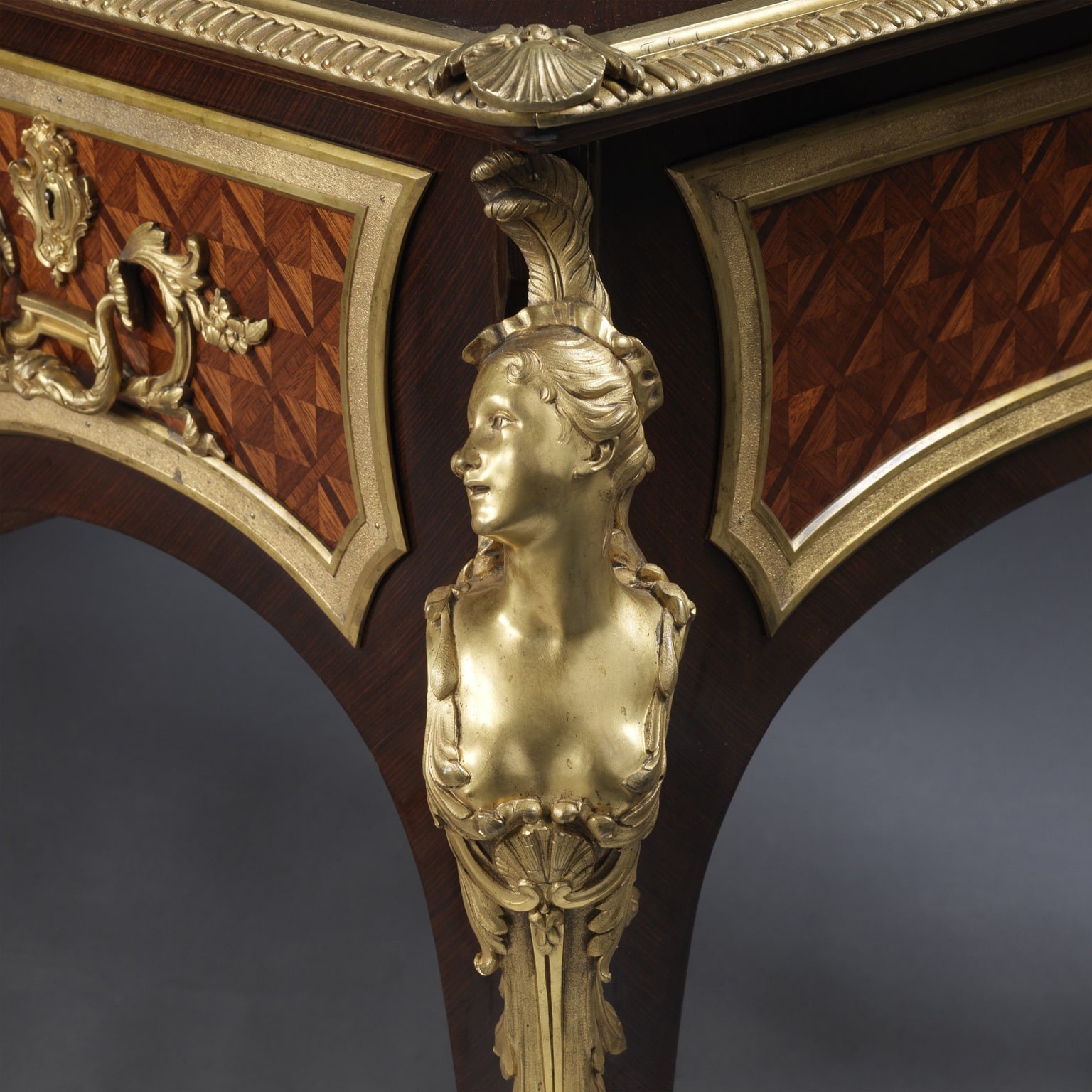François Linke
A Magnificent Regence Style Trellis Parquetry Bureau Plat
£90,000
A Magnificent Regence Style Gilt-Bronze Mounted Trellis Parquetry Bureau Plat by François Linke. Linke Index No. 795. Signed to the gilt-bronze border...
Dimensions
Height: 79 cm (32 in)Width: 170 cm (67 in)
Depth: 96 cm (38 in)
Description
A Magnificent Regence Style Gilt-Bronze Mounted Trellis Parquetry Bureau Plat by François Linke.
Linke Index No. 795.
Signed to the gilt-bronze border ‘F. Linke’.
Stamped ‘FL’ to the reverse of the gilt-bronze handles
Stamped to the lock ‘CT LINKE SERRURERIE PARIS’ and no. ‘795’.
This fine bureau plat has a rectangular trellis parquetry top with a gilt-bronze dentilled surround and scallop shell clasps to the corners. The frieze is fitted with three drawers to the front and three dummy drawers to the reverse, all with foliate-cast frame and handles. The sides of the desk are centred by Bacchic masks and the corners headed by sculptural gilt-bronze female espagnolettes. The bureau is raised on tapering cabriole legs with acanthus wrapped paw feet.
The original model for this sophisticated bureau plat was made by the important 18th century ébéniste Charles Cressent and now resides at the Huntington Library, San Marino, California. [Object Number: 27.18 ]. The model is distinguished by lively sculptural female espagnolettes to the corners with feathered head-dresses. The mounts were first described by officers of the founder’s guild in a list of bronzes seized in Cressent’s workshop in 1723 as “quatre termes de moyenne grandeur avec des testes de femmes coiffées de plumes et aigrettes, dont le buste est en console” (four terminal figures of medium size with female heads dressed with feathers and tufts). The asymmetrical composition of the figures with their turned heads and suggestion of movement, reflect Cressent’s shift stylistically from the more static forms of the Baroque to a more whimsical and lively Rococo style. The Bacchic masks to the sides of the desk, although derived from baroque models of André-Charles Boulle (1642-1732) from the turn of the century, have also been updated to reflect this new Rococo style with the addition of asymmetrical foliage.
The original bureau plat by Cressent was used for the signature of the Peace Treaty at Versailles in 1919.
French, Circa 1890.
Date
Circa 1890
Origin
France
Medium
Parquetry and Gilt-Bronze
Signature
Signed to the gilt-bronze border ‘F. Linke’. Stamped 'FL' to the reverse of the handles.
François Linke (1855 – 1946) was the most important Parisian cabinet maker of the late nineteenth and early twentieth centuries, and possibly the most sought after cabinet maker of his period.
He was born in 1855 in the small village of Pankraz, in what is now the Czech Republic. Records show that Linke served an apprenticeship with the master cabinetmaker Neumann, then in 1875 at the age of 20 he arrived in Paris where he lived until he died in 1946.
It is known that the fledgling Linke workshops were active in Paris in the Faubourg St. Antoine as early as 1881, and during this time he supplied furniture for other more established makers such as Jansen and Krieger.
The quality of Linke’s craftsmanship was unsurpassed by any of his contemporaries and reached its peak with his spectacular stand at the Paris Exposition Universelle in 1900, where his Grand Bureau took the gold medal. He gambled his fortune and reputation on this stand, exhibiting several breathtaking items of furniture with sculptural mounts of the most exceptional quality and proportion. His gamble worked and his reputation was established to such an extent that Linke continued to be the pre-eminent furniture house in Paris until the Second World War.
As the Art Journal reported in 1900 on Linke’s stand:
‘The work of M. Linke … was an example of what can be done by seeking inspiration amongst the classic examples of Louis XV and XVI without in any great sense copying these great works. M. Linke’s work was original in the true sense of the word, and as such commended itself to the intelligent seeker after the really artistic things of the Exhibition. Wonderful talent was employed in producing the magnificent pieces of furniture displayed….’
The formation of Linke’s distinctive style was made possible by his collaboration with the sculptor Léon Messagé. Together Linke and Messagé designed furniture for Linke’s 1900 exhibition stand, with exuberant allegorical figures cast in high relief, that exemplified Linke’s ability to seamlessly merge the different mediums of wood carving, bronze and marquetry into a dynamic unified whole.
Today Linke is best known for the exceptionally high quality of his work, as well as his individualism and inventiveness. All of his work has the finest, most lavish mounts, very often applied to comparatively simple carcasses. The technical brilliance of his work and the artistic change that it represented were never to be repeated.
Bibliography:
Payne, Christopher. François Linke, (1855 – 1946), The Belle Époque of French Furniture, Antique Collectors’ Club, (Woodbridge, UK), 2003.
Meyer, Jonathan. Great Exhibitions – London, New York, Paris, Philadelphia, 1851-1900, Antique Collectors’ Club, (Woodbridge, UK), 2006; pp. 298 – 300.
Ledoux – Lebard, Denise. Les Ébénistes du XIXe siècle, Les Editions de l’Amateur, (Paris), 1984; pp. 439-43.
Revue Artistique & Industrielle, (Paris), July-August 1900.
Coral Thomsen, D. (ed), The Paris Exhibition 1900, The Art Journal, 1901; p.341.















 Print
Print


